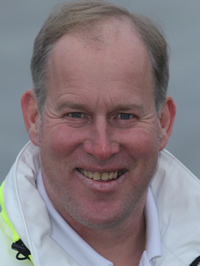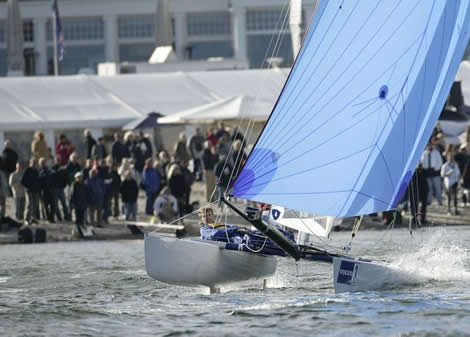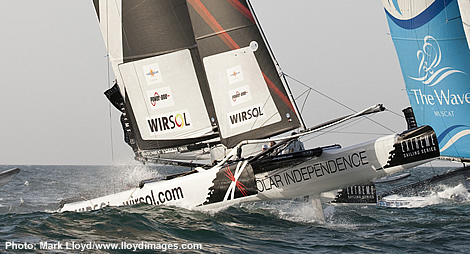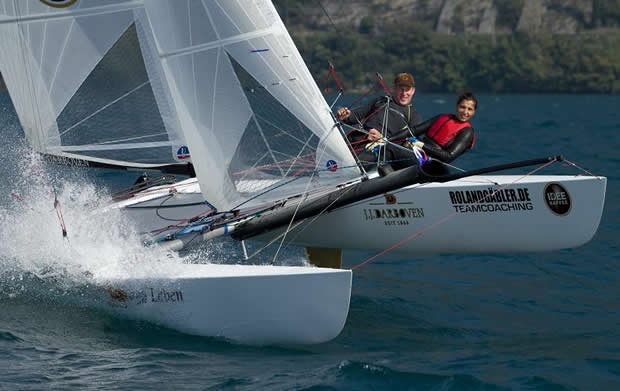Catamarans in Rio
When it comes to catamaran enthusiasts, few are more passionate than Sydney Tornado bronze medallist, German Roland Gaebler. He is Chairman of the International Tornado Class Association and current World Champion, a title he won last year sailing with wife Nahid. So he is understandably pleased at the moment: firstly with the prospect of a catamaran returning to the Olympic Games in 2016 and secondly that the present proposal has it as a mixed class.
Currently all the Olympic classes are hanging on for the ISAF Mid-Year Meeting, due to take place in St Petersburg, Russia over 4-8 May. At this meeting it is believed the ‘events’ for the 2016 Olympics will be finalised, but in some cases not the equipment which will subsequently be subject to evaluation trials [read our interview with Carolyn Brouwer about this here]. One event where the equipment is likely to be up for evaluation is the catamaran.
“At the moment we are the only [catamaran] class that wants to go back to the Olympics,” states Gaebler. “The F18 class has said it is not good for them, but if we go to an evaluation event maybe some other boats will come.”
 Gaebler is obviously keen for the Tornado to be chosen and the class has already taken steps to try and ensure that the 44 year old Rodney March design is reinstated, by in particular making the boat even more one-design and reducing costs – the case for the Tornado can be read here. In particular the sails are now one design and a full set lasting the year can be purchased for 3,500 Euros.
Gaebler is obviously keen for the Tornado to be chosen and the class has already taken steps to try and ensure that the 44 year old Rodney March design is reinstated, by in particular making the boat even more one-design and reducing costs – the case for the Tornado can be read here. In particular the sails are now one design and a full set lasting the year can be purchased for 3,500 Euros.
While parts of the Tornado may be getting long in the tooth, the class has not been afraid to upgrade it. Prior to Athens a spinnaker and extra trapeze were added and now Gaebler’s personal view is that it is time for the hulls to be upgraded. He foresees them possibly taking two or three examples of the ‘Tornado’ (even if none of the original March design remains) to an evaluation trial, each possibly having a different hull shape/platform.
“I think the Tornado could go back like it is, but if we want to stay as an Olympic class we should think about the hull design and make the change now and not wait four years when everyone would have to buy new boats. That is my view, but I have to ask the others who say it should stay as it is. For sure the Tornado is still one of the fastest boats – we can still beat all the F18s and some of the carbon boats on the market. We are at the high end limit, but we should be ahead of the curve.”
So Gaebler can foresee a new Tornado platform fitting beneath the already upgraded carbon fibre Tornado rig, for, as he says, “the Tornado rig is still the fastest. It is perfect for 140-150kg [crew]. No one has such as a fast rig and it is very light and stable and doesn’t break. I am still using a six year old mast and the sails are high quality.”
He also considers what to do with the foils. The trend is to go for ORMA 60-style curved daggerboards, but Gaebler points out: “sometimes they work fine, but maybe we need to work on the rudders, because you see the boats coming out at the front and not the back and sometimes the crew falls out because they get lifted into the air. So there are things we have to work on, but then - let’s go for it!”
Gaebler also observes that catamaran design generally is heading down a similar track, with for example reverse sheer bows and hulls that are easier to manoeuvre. As a result he thinks there is likely to be little disagreement on this between manufacturers who pitch up to evaluation trials.
“We all know what the boat has to look like. There is some discussion about 18 or 20ft. For me it should look like an A-cat, slim long hulls and 18-20ft. I am totally in favour of 20ft. We need to have a modern design, that allows 10 boats to fit in one container to make the logistics cheap. Then we can have it for the next 20 years and then we can change again. That’s the wish I have.”
Because of this the ITCA has already been in touch with other beach catamaran manufacturers such as Hobie and Nacra, with a view to a possible collaboration.
“With an evaluation event you have one winner and nine losers, we all have to invest 60-80,000 Euros to be good in this evaluation. We all know how a modern multihull should look - it should be spectacular, powerful, fast – so why don’t we make an agreement where Hobie or Nacra build it.” Or least other manufacturers getting a slice of the action.
He emphasises that the boat needs to be a very strict one design and, unlike some other Olympic class, built to a high quality. “It might cost 2-4,000 Euros more, but then you have a boat you can sail for four or five years. I could name some classes, I don’t like to say them, but after one year you see the boat is going soft and you see some crews who have to have two or three. This is not fitting the Olympic spirit I think. I think it should be very strict, very high quality, very good control, so if you pay a lot of money, but for that you get a high performance, action-loaded boat, then you can go for the sponsors and the media. That is my personal wish.”
Gaebler is in good shape if in May it is decided that the catamaran remains mixed. However there are other possibilities. Some MNAs are campaigning for there to be equality across the genres of boat – ie two singlehanders, two doublehanders, two keelboats, two multihulls, etc, five men and five for women. “Or we say mixed like we are now. Many sailors say ‘mixed - it’s a joke’. But I say ‘since I sail mixed I have more sponsors and have doubled the media because they like the emotion between men and women, all the stuff that’s happens. It’s a couple and it’s a nice story - we’ve experienced it as a nice way to go.”

Aside from getting the cat back, Gaebler is campaigning hard that when it returns it is in a stadium-style racing format, or ‘arena’ style as he calls it. He has been a major advocate of this as one of the creators of the Volvo Champions Race that ran in Germany in 2003 when Tornados and 49er competed on short courses right up by the shore for the benefit of gathered spectators.
“For me it is the best way to show sailing to the public. Also I always see 20-30% of the people watching are young kids. So we have to bring sailing as close as possible to spectators - for me it is the only way. Some classes like to do it and some don’t. The Extreme 40 takes it to the extreme because the boats are big and they are nearly sailing on the same course that we do with the Tornado.”
Significantly Gaebler believes that when they race the catamaran in Rio 2016 it should be with a stadium-style format not just for the medal race, but for all their races.
Obviously this format doesn’t suit all boats. But it does particularly work for fast spectacular boats. “I believe the Tornado and other multihulls are excellent for it, because if you look at the images with the double trapezes and the high speed boats, they look fantastic. If we are going back to the Olympics with a multihull we don’t just want to do only the medal race in that style. We want to do every race like that and then we will get sponsors and the media.
“And we must start on time and we must guarantee that,” he says, words that recently came out of Russell Coutts’ mouth when we interviewed him. “I did commentary for the America’s Cup in 2003, 2007 and 2010 and always the start was delayed. So whether it is 1 or 35 knots we have to start on time otherwise the media come once and then they go and don’t come back. We have to be very strict on this and you can do it only with some boats and only with some sailors.”
The criticism of this stadium-style racing is that winds that close in to shore are fickle and can make a mockery of the result - more lottery than sport. This is not the first time this has been pointed out to Gaebler. “When we started this in 2003 there was a big discussion going on about that. All the sailors were saying ‘this is unfair, the wind is shifting, etc’. I said, ‘okay we are doing shorter races, but we are doing more races’. So instead of sailing four races per day, we are sailing 10 and still the best sailors are winning. Like in the Tornado [in the Volvo Champions Race] Darren Bundock was still winning on the short courses.
“At the end of the day – what I like about short course racing is you have to look to other things. You have to look more at the flags ashore or the trees. It is completely different and for me it is also much more emotional because positions are changing much more quickly. It is bit like sailing a rugby game inside a very small stadium. I think this is what sailing really needs: starting on time, full action in a very small area and I think we are doing it very well with the Extreme Sailing Series and we must also do it at the Olympics as well. Multihulls and skiffs are excellent for this.”
While he continues to campaign both on the water and ashore for the Olympic catamaran, Gaebler this year is taking part in the Extreme Sailing Series as skipper of Team Extreme! In Oman last week they finished ninth out of 11 boats but Gaebler (in fact like several teams we spoke to...) said they had had less training than the rest.
"We had major problems in light wind upwind speed. We had some good starts but we lost it on the first upwinds. But we are right at the beginning. We’ve only had six days of training and we have many things to do. We are happy with are going around the course without major crashes and we keep clear. Step by step we are getting into it.”
In Oman Gaebler was sailing with catamaran-converted Finn medallist Sebbe Godefroid and North Sails France guru Bruno Dubois, both veterans of the Extreme Sailing Series, with their fourth crew German Formula 18 sailor Mikael Walters. Gaebler was so impressed with sailing in Oman that he says he is planning on returning next winter and using it as his training venue.
However this depends upon what unfolds. He says his campaign on the Extreme Sailing Series is one of the lowest budget, sailing a boat provided by OC with the remit that for each of the ESS regattas that take place around the world this season he has to sail with one local crewman on board.
“It is quite risky and it is not good for making progress, but I have a boat, I have a little sponsor so we are sailing all nine events and in 2012 I am planning to have a fully professional campaign. For the next year I want a proper budget othereise I won’t continue. I want to have the same chance as Rothschild, otherwise I’ll go back to the Tornado.”



































Latest Comments
benremocker 05/03/2011 - 19:05
We're running some more trials of "Theater Style" racing in the 49er in March. Theater style is similar to the Arena style in that it is a short course where the boats are contained. One major difference is that it's tailored for a TV audience more than a live audience as we use swim lanes to create an artificial boundary but keep good quality wind. Have a read about the plans at: http://www.porttackcharter.com/2011/02/23/palma-test-of-theater-style-ra...Add a comment - Members log in